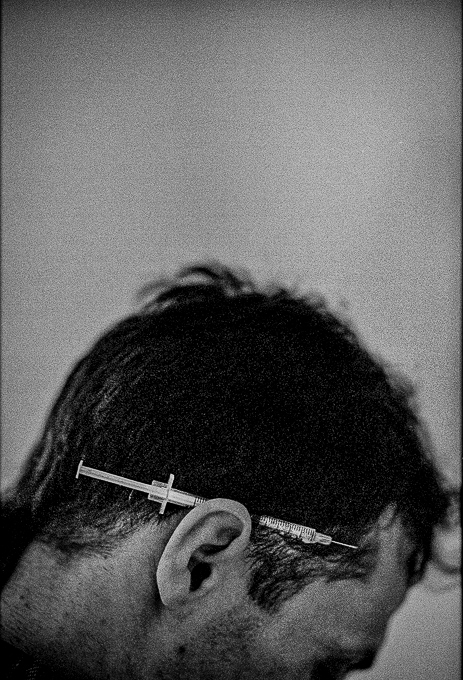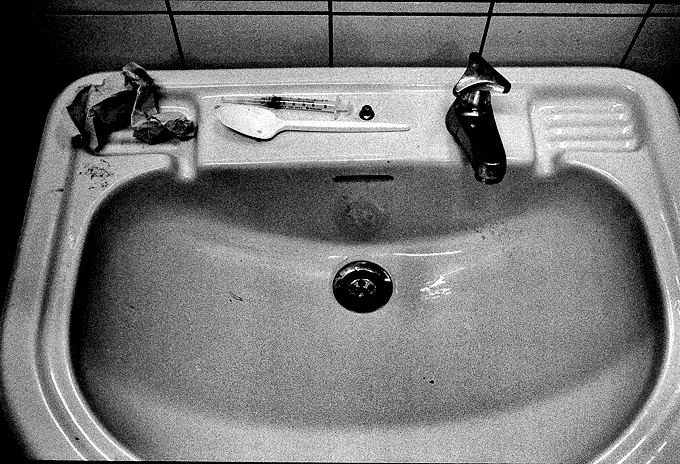Safe Sites
By Joe Sciarrillo
“Safe consumption sites are a basic public health practice. Drug users don’t want to use on the streets, but often, they don’t have access to a private, sanitary place to consume substances. Every study of safe consumption sites has noted significant reduction in outdoor drug use.”
Anna berg, LCSW, Director of Programs The Harm Reduction Therapy Center
.

While California cities still lack the political will and legal strategy to set up safe injection sites, non-profit groups are on the frontlines, pushing for these sites to open in San Francisco. Groups like Health-Right 360, Homeless Youth Alliance, TransThrive, Glide, the Harm Reduction Therapy Center, and the Drug Users Union have been doing street outreach to make sure that people have harm reduction supplies to find safer ways to inject or smoke in informal public, congregate sites. Their common goal is to treat drug use as a public health issue and to prevent the overdoses and infections that tend to correlate when drug use is driven underground. This public health approach includes having Naloxone (Narcan) on hand at sites to administer to reverse drug overdoses. Ironically, many of these outreach programs are funded by the city’s Department of Public Health. Or are done in conjunction with UCSF medical staff. However, a city-run site is yet to open in California, largely due to concerns over lawsuits and push-back from neighbors.
New York City set an example for the nation by opening the country’s first safe injection sites back in 2021. That city opened two in Uptown: one in Harlem and another in Washington Heights. Finally, for the first time, the U.S. government is funding studies to assess the effectiveness of these sites to prevent overdoses. Such sites have attracted the fed’s attention as more law makers are understanding that traditional enforcement (War on Drugs) has been unable to treat the root causes of substance use, addiction, and the national crisis of overdose deaths. Over 100,000 people in the U.S. have been dying of overdoses (largely due to fentanyl) each year since 2021. The increased implementation of law enforcement measures to stop drug use appears to push users to society’s margins and away from lifesaving treatment.

Rotterdam, Netherlands. 1990 Photo: Robert Gumpert
Harm reduction strategies, used in many other countries, have shown that a public health approach can largely prevent overdose deaths, decrease the transmission of diseases, and foster trust with care providers who can offer therapy, social services, and rehab programs. These sites include private booths and rooms where users may bring their own substances to use while medically trained staff are on standby to intervene if first aid or overdose reversal is needed. Drugs are not sold nor are they handed out by staff. Only medical supplies, clean needles and pipes are given on site, with the goal of preventing infection and to discourage people from using contaminated or shared items from outside. Fentanyl testing tools are also on site, to prevent users from taking substances that have been unknowingly mixed with fentanyl (which is a common reason for overdoses).
San Francisco may be on its way to hosting safe injection sites later this year. Mayor London Breed and the Board of Supervisors have approved such sites if they are operated by private agencies, and no city funds are used. Officials remain unclear about when exactly these sites will open. Or where.
As a street outreach social worker, I meet folks every day who see harm reduction programs as a lifesaver. Particularly those living on the street, in tents, RVs, or in doorways have plenty of stories to share of lives being saved due to clean needles and Narcan being distributed by outreach workers. Every week, I hear community members tell me that they were able to save a friend from dying of an overdose since they or a neighbor had Narcan on hand in their tent. Sometimes, one Narcan nasal spray is not enough to reverse an overdose and people resort to using four or more nasal spray devices and applying CPR to revive someone. Sometimes they do not have any Narcan or do not have enough health care support and they tragically become one of the 268 people who died of an overdose in the first 4 months of 2023. If the city were to formally setup sites, folks who use drugs would have more opportunities to access medical care, clean needles to prevent HIV and Hepatitis B and C, Narcan to prevent overdose, and possibly rehab services.
Governor Newsom vetoed a state bill in August 2022 that would have permitted safe injection sites to start as pilot programs in San Francisco, Oakland, and Los Angeles. Groups opposed to these sites, like the San Francisco Police Officers’ Association, claim that safe injection sites will attract drug users to those areas and increase crime rates.
Both Newsom and Breed have blocked legislative efforts to pass these sites, in a similar way to how former mayor Dianne Feinstein blocked needle exchange programs in the 1980s due to political pressure and their hopes for ascending to higher offices.
Anna Berg, director of programs at the Harm Reduction Therapy Center, has been a longtime advocate for safe injection sites. Many advocates like her have cited the closing of the Tenderloin Linkage Center as an unfortunate, yet foreseen, major factor leading to a recent rise in overdose deaths. Now that a central informal site for users has closed, there is a void for central care, especially for users who are not aware of, or not living near, other smaller clinics that might have medical staff on site with harm reduction supplies. Anna Berg explains further, “when someone is ready to seek additional care, they have a safe place and people who know them where that conversation can begin. Safe consumption sites are also a basic public health practice: drug users don’t want to use on the streets. But often, they don’t have access to a private, sanitary place to consume substances. Every study of safe consumption sites to date has noted significant reduction in outdoor drug use. Safe consumption sites are one of the best, lifesaving, money-saving, community-safety-building measures we can use to help combat the negative consequences of drug use. And they must be a cornerstone of any successful attempt to curb the dramatic increase in overdose deaths in the United States.”
Meanwhile, City Attorney David Chiu is reportedly holding up plans over legal concerns for the city if a site were to open. Between 600 to 700 people have died of drug overdoses in San Francisco each year since 2020. Over 100,000 people die in the USA per year due to overdoses. How much longer can we wait before our cities open these life-saving treatment sites?
For help, treatment, or further support on the topics listed about, please see:
SAMHSA – Substance Abuse and Mental Health Services Administration
1-800-662-4357 SAMHSA National Helpline
Behavioral Health | San Francisco (sf.gov)
…